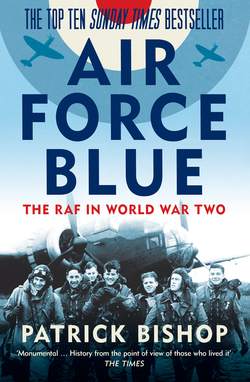Air Force Blue: The RAF in World War Two – Spearhead of Victory

Реклама. ООО «ЛитРес», ИНН: 7719571260.
Оглавление
Patrick Bishop. Air Force Blue: The RAF in World War Two – Spearhead of Victory
Copyright
Dedication
Contents
Maps
Firstway
The Big One
A Cottage or a Castle?
Smoke and Mirrors
Brylcreem Boys
‘There’s Something in the Air’
‘Tragic, Criminally Tragic’
The Battle
Fighting the Night
Ten Million Miles of Sea
The Blue
‘Eat, Drink and Be Merry …’
‘Britain’s Best Advertisement’
Out of Sight
Black and White
The Hyacinths of Spring
Brothers and Sisters
Acknowledgements
Notes
Picture Section
Index
Also by Patrick Bishop
About the Author
About the Publisher
Отрывок из книги
ANGEL GIRL IN CHIEF
.....
Campbell’s Tallboy was fuzed at twenty-five seconds.15 From a Lancaster following close behind, rear gunner Flight Sergeant E. J. Cutting watched ‘a twelve thousand pounder land about a hundred yards from Hitler’s house’.16 There was ‘a terrific flash and though we were flying pretty high we could hear the explosion above the roar of our engines and the whole plane seemed to rock,’ he told radio listeners. Then ‘great piles of earth came shooting up, high into the sky. I thought to myself well, even if that’s a bit short, it must have damaged the place. But just at that moment there was another flash, followed by a huge explosion. One of the other aircraft had planted its twelve thousand pounder bang on the target.’
By now the Main Force squadrons had arrived and the sky over the valley was dangerously crowded with huge aeroplanes. Cutting’s pilot reported at the post-operation debrief that ‘interference from other aircraft was so great’ that he was unable to identify the target on the run-in and was ordered by the master bomber controlling the operation from another Lancaster not to bother making a second effort. Another pilot, Squadron Leader James Melrose, stated that ‘just as the bomb aimer was preparing to drop the bomb, the aircraft was narrowly missed by a bomb from [an] aircraft above, and the target was accordingly overshot and it was impossible to bomb’.17 Fred Whitfield’s main concern was the anti-aircraft fire. The gunners had found their range and ‘the sky was black with flak’.18 The bomb aimer, Phil Jackson, seemed unaware of the shells rocking their kite as he talked Ron Adams in. Then Q-Queenie ‘appeared to leap a thousand feet in grateful thanks for being relieved of five tons of metal’. Relief was brief. A few seconds later he heard a ‘huge bang … we went into a steep dive. The port engine was on fire.’ Then came ‘another almighty bang’ apparently caused by one of the giant bombs hitting the top of the mountain. This blast hurled Q-Queenie upwards, blowing out the flames licking around the engine in the process. Swinging his turret to port Whitfield looked back up the inside of the aircraft for damage and saw jagged holes in the fuselage but the Lancaster flew on unperturbed. As they turned away he had a grandstand view of the Main Force attack.
.....